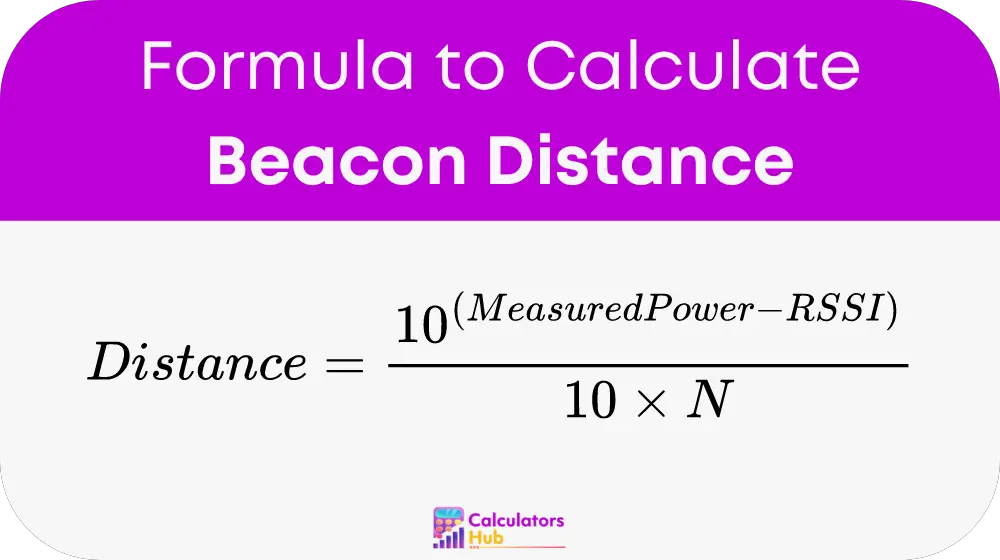The Beacon Distance Calculator estimates the distance between a beacon and a receiver by using the Received Signal Strength Indicator (RSSI) and a known reference value, typically provided by the beacon manufacturer. The calculator accounts for environmental factors that affect signal propagation, providing a more accurate distance estimate. This tool is essential for developers, network engineers, and marketers who rely on precise location data to enhance user experiences and operational efficiency.
Formula of Beacon Distance Calculator
The Beacon Distance Calculator operates using the following formula:

Explanation:
- Measured Power: The RSSI value (in dBm) at a reference distance, typically 1 meter from the beacon. This value is often provided by the beacon manufacturer and represents the signal strength at a known distance.
- RSSI: The current Received Signal Strength Indicator value (in dBm) measured by the receiver. This value indicates the strength of the beacon’s signal at the receiver’s location.
- N: The path-loss exponent, which accounts for the environment’s effect on signal propagation. The value of N typically ranges between 2 (representing free space) and 4 (representing indoor environments with obstacles such as walls and furniture).
How It Works:
- Measured Power: A constant provided by the beacon manufacturer, representing the expected signal strength at a reference distance (usually 1 meter).
- RSSI: The signal strength observed by the receiver, which diminishes as the distance from the beacon increases.
- N: Adjusts the calculation based on environmental conditions. For example, N = 2 is used in open spaces, while higher values (3-4) are used in indoor settings with multiple obstacles.
By plugging in these values, the formula calculates the estimated distance between the beacon and the receiver.
Table for General Terms
Understanding key terms is essential for effectively using the Beacon Distance Calculator. Here’s a table of relevant terms:
| Term | Definition |
|---|---|
| Beacon | A wireless device that broadcasts signals at regular intervals, often used for location tracking. |
| Received Signal Strength Indicator (RSSI) | A measure of the power level that a receiver observes from a beacon’s signal, expressed in decibels relative to 1 milliwatt (dBm). |
| Measured Power | The RSSI value at a known reference distance from the beacon, usually 1 meter. |
| Path-loss Exponent (N) | A factor that accounts for signal loss due to environmental factors, ranging from 2 in open spaces to 4 in more obstructed environments. |
| Distance (meters) | The estimated distance between the beacon and the receiver, calculated based on RSSI and environmental factors. |
Example of Beacon Distance Calculator
Let’s explore a practical example to demonstrate how the Beacon Distance Calculator works:
Scenario
Imagine you are deploying beacons in an office building to provide indoor navigation for visitors. You need to estimate the distance between a beacon and a receiver (such as a smartphone) to ensure accurate location tracking.
Inputs:
- Measured Power: -59 dBm (as provided by the beacon manufacturer for 1 meter distance)
- RSSI: -70 dBm (observed signal strength at the receiver)
- N: 3 (since the office has several walls and obstacles)
Calculation:
Using the formula:
- Distance (meters) = 10 ^ ((-59 – (-70)) / (10 * 3))
- Distance (meters) = 10 ^ (11 / 30) ≈ 1.41 meters
Interpretation:
The Beacon Distance Calculator estimates that the receiver is approximately 1.41 meters away from the beacon. This distance estimate helps in fine-tuning the beacon placement for optimal signal coverage and accurate location tracking within the office.
Most Common FAQs
The accuracy of the Beacon Distance Calculator depends on the precision of the input values, particularly the Measured Power and the RSSI. Environmental factors like walls, furniture, and interference can affect signal strength, making the path-loss exponent (N) a critical factor in achieving accurate results.
Yes, the calculator can be used both indoors and outdoors. However, the path-loss exponent (N) should be adjusted based on the environment. Outdoor settings typically have lower N values (around 2), while indoor settings may require higher values (3-4) due to obstacles.
The path-loss exponent (N) accounts for the environment’s effect on signal propagation. In free space, N is typically around 2, but it increases in environments with obstacles like walls, doors, and furniture. Adjusting N helps in obtaining a more accurate distance estimate based on the specific environment.